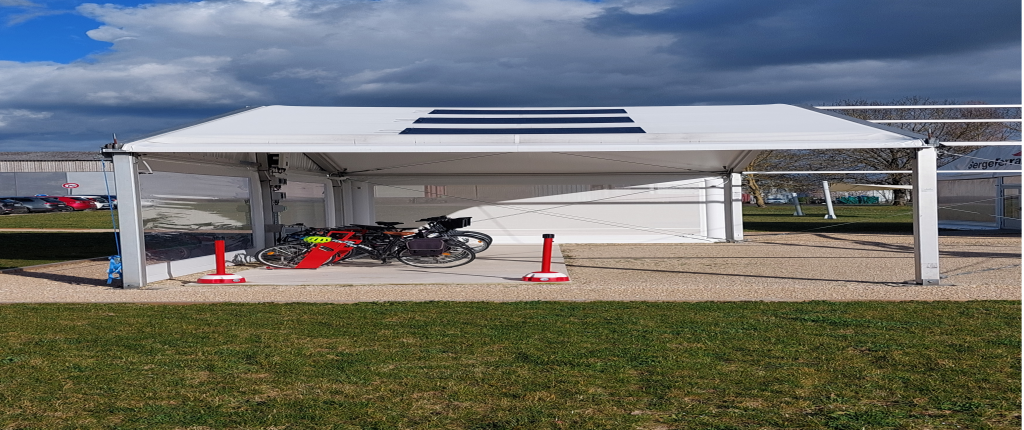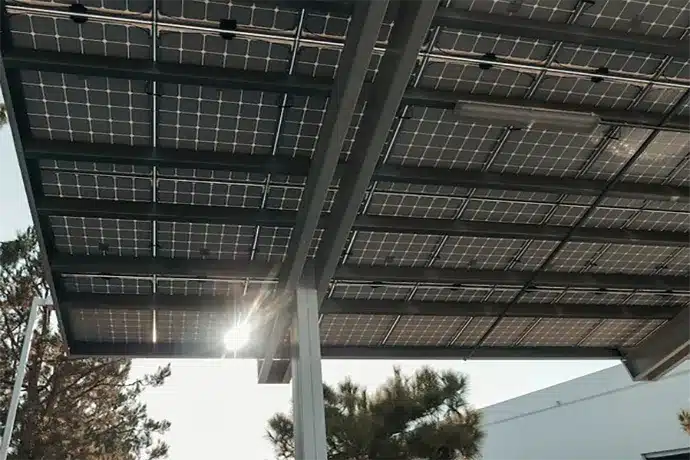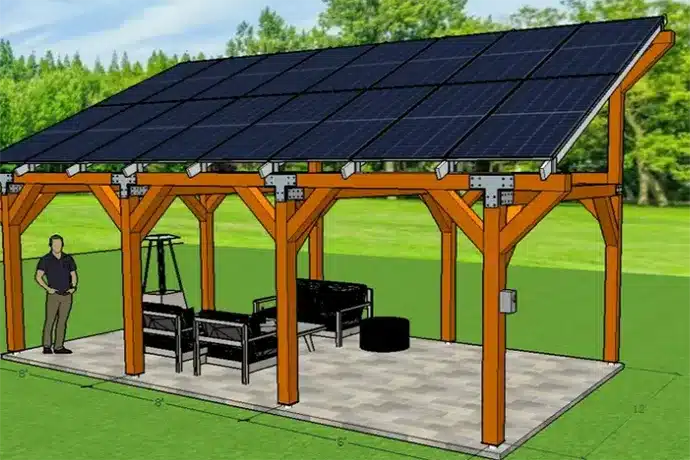Table of Contents
In the contemporary era of seeking sustainable lifestyles, solar pergola, or solar panel pergolas, have become an increasingly popular choice for their unique design and functionality.
More than just a space to provide shade, the modern solar pergola is also capable of converting sunlight into electricity, bringing clean energy to your home.
In this post, Sungold will take you through key topics such as how solar pergolas work, pros and cons, cost estimates, how to install a solar panel pergola, and how to choose the right supplier.
Whether you are an environmental advocate or a solar homeowner, this information will help you better understand solar pergolas and how a pergola with solar panels can revolutionize your life.
What is a solar pergola?
A solar pergola is an outdoor structure that incorporates solar panels and is designed to provide shade and a resting area while generating clean, renewable energy.
Not only do these freestanding solar pergola shade structures add beauty and functionality to an outdoor space, but by installing solar panels they can contribute to the environment by powering a home or storing excess power in a battery system.
Solar pergola design is highly flexible and can be customized to suit the needs of the home, space constraints, and individual aesthetic preferences.
Whether used as a cozy shaded spot in the garden or as a green corridor connecting indoor and outdoor spaces, pergolas with solar panels represent an innovative and sustainable energy solution for the home.

How does a solar pergola work?
Solar pergolas skillfully capture and convert sunlight through pergola solar panels installed on their structure, converting the power of natural light into clean electricity. The photovoltaic cells built into these panels utilize the photovoltaic effect to convert solar energy into electricity.
In this innovative design, solar panels on pergola not only form the roof of the pergola but are also carefully laid out to ensure that they receive the maximum amount of sunlight.
The placement of the solar panels takes into account the orientation and angle and is precisely adjusted to suit the geographic location and the sun’s trajectory.
For example, in the UK, backyard solar panels pergola are best installed facing south at an angle between 20° and 50° to maximize sunlight. For pergolas with flat or slightly sloping roofs, the panels can be easily adjusted to the ideal angle by placing brackets underneath the panels to ensure maximum efficiency.
With high-efficiency solar panels such as the Sungold 450W SGM series, solar panel pergola kits can be a powerful source of energy for your home’s self-sufficiency. solar pergola kits not only power your home’s appliances but the excess energy can be stored or fed back into the grid, providing an energy income for the home.
Solar Panel Pergola: Pros and Cons
Advantages of solar pergolas
- Provides an opportunity to utilize solar energy: Provides an opportunity for homeowners who do not have a suitable roof to install solar panels to utilize solar energy.
- Effective use of garden space: allows the space below to be used for leisure activities, avoiding the problem of ground mounted solar panels taking up garden space.
- Aesthetics: installing solar on pergola may provide a more aesthetically pleasing solar solution than roof mounting.
- Extend energy generation: offers a viable option for homeowners who already have solar panels installed but want to increase the amount of electricity produced.
- Maintains garden usability: preserves space for walking in the garden even after installing solar panels.
Disadvantages of solar pergolas
- Higher cost: pergolas with solar panels cost more to install initially compared to regular pergolas.
- Space constraints: when adding solar panels to an existing pergola, it may turn out that the available space is not enough to accommodate the required number of solar panels.
- Installation costs: If the pergola has a flat roof, it will cost more to install the solar panels at the proper angle.
- Affected by shadows: Since pergola roofs are usually not high, solar panels may fall in the shadows of nearby trees or buildings, reducing electricity production.
| Pros | Cons |
|---|---|
| Increases solar utilization | Higher initial costs |
| Effective use of garden space | Potential space limitations |
| Aesthetic energy solution | Higher installation costs |
| Allows for expanded energy production | May be affected by surrounding shadows |
What is the cost of a solar panel pergola?
The cost of a solar panel pergola varies depending on whether you are installing solar panels on an existing pergola or building a brand new solar pergola.
If you are planning to buy and build a new pergola, the cost will probably be between £3,000 and £8,000 (for reference only). Add the cost of the solar panels and the price range for the whole project could be even wider.
Using the Sungold 450W solar panel as an example, a pergola of approximately 6 square meters can accommodate three to five of these panels.
Considering the high efficiency of the Sungold 450W solar panels, a configuration of three panels can provide enough power to support the basic needs of the average household, while five panels can provide a larger amount of power for households with higher power needs.
When considering only the cost of the solar panels and their installation, the total cost of three to five Sungold 450W solar panels is approximately £2,108 to £3,513. This estimate includes the cost of the solar panels themselves and their installation but does not include the cost of building or remodeling the pergola.
Therefore, if you already own a solar pergola kit, you will only pay between £2,108 and £3,513 for the solar panels and their installation. If you plan to build a solar pergola from scratch with Sungold 450W solar panels, the overall cost could be between £5,108 and £11,513, depending on the design of the pergola, the materials used and the number of solar panels you choose.
This price range offers an opportunity to move towards sustainable living, and despite the initial investment, a solar pergola can save you money on your electricity bill and provide clean, renewable energy in the long run.
Can a solar panel pergola qualify for the federal solar tax credit?
Absolutely yes, solar panels mounted on a pergola do qualify for the U.S. Federal Solar Tax Credit (Investment Tax Credit, ITC), subject to certain conditions being met.
This tax credit is one of the incentives offered by the U.S. government to encourage the adoption of renewable energy and is designed to make renewable energy systems more affordable for the average homeowner. There are even people who can get free solar panels from the government.
Under the ITC, homeowners can deduct a percentage of the installed cost of a solar energy system, including the cost of solar panels, related equipment, and installation, on their federal tax return. The exact percentage of the credit depends on the year in which the solar system was installed.
To qualify for this tax credit, the solar pergola must be installed on your primary or secondary residence in the U.S. and used to generate electricity for that residence. In addition, the system installation must meet all applicable local building codes, regulations and safety standards.
Homeowners should also be aware that in addition to federal tax credits, certain state and local governments may offer additional incentives, such as rebates or other tax benefits, to further encourage the installation of solar energy systems.
Finally, it is highly recommended to consult with a tax professional or renewable energy expert before undertaking a solar pergola project to ensure that all incentives and tax benefits applicable to your specific situation are fully understood and utilized.

How much solar energy can a solar panel pergola produce?
The amount of solar energy generated by a solar panel pergola depends on several key factors, including the number and efficiency of solar panels installed, the size of the pergola solar its total available surface area, and the amount of sunlight the unit receives.
Under ideal conditions, a typical home solar panel can produce between 200 and 450 watts of electricity. For example, if a solar panel pergola is installed with six panels capable of producing 450 watts of power each, it can produce up to 2,700 watts per hour in full sunlight. Even with 80% losses, that’s still 2,160 watts of power.
To estimate the daily energy production of a solar pergola, you can calculate the total wattage of all the panels and refer to the average number of hours of sunshine in your area.
However, actual energy output is affected by geographic location, seasonal variations, and current weather conditions, which means that the amount of power produced may vary at different times.
Can you install solar panels on a pergola?
First of all, Sungold suggests trying to get a professional to install pergolas with solar panels. if you are knowledgeable in this area, you can opt for DIY.
The installation process of pergola solar panels involves several key steps designed to ensure structural stability while maximizing the efficiency of solar energy utilization. Here is the basic process of solar panels pergola installation:
- Structural inspection: If the solar panels are planned to be installed on an existing pergola, the installation team will first need to inspect the structure of the pergola to confirm that it is stable enough to carry the additional weight of the solar panels.
- Installation of brackets and mounting systems: after confirming that the pergola is structurally sound, the installers will install specialized anchors and mounting systems on the roof of the pergola, which are used to hold the solar panels securely in place.
- Installation of solar panels: The solar panels will then be installed on the pergola roof, secured by the previously installed brackets and mounting systems. The use of high efficiency solar panels, such as the Sungold 450W solar panels, ensures a highly efficient energy conversion.
- Connecting to the home electrical system: after installing solar panels for pergola, the next step is to connect them to the home’s electrical system. This usually involves laying out cables between the house and the pergola, as well as possibly digging up some ground to bury these cables.
- Install an inverter: The direct current (DC) generated by the solar panels needs to be converted to alternating current (AC) by an inverter before it can be used by the home’s electrical system. Inverters are usually installed near the home’s electrical equipment for easy connection and use.
- Building a new pergola (if applicable): If the project involves building a brand new solar panel pergola, the construction of the pergola will need to be completed before the solar panels can be installed. This includes choosing the right materials, constructing the frame, and ensuring the stability and durability of the entire solar pergola shade structures.
The entire installation process requires a combination of the optimal layout, angle, and orientation of the solar panels to capture as much sunlight as possible. With careful planning and professional installation, a solar panel pergola will not only provide outdoor shade space but also effectively provide clean energy for your home and achieve energy self-sufficiency.

How do you choose the right solar panel supplier?
When planning a solar pergola project, choosing the right solar panel supplier is critical, not only for panel efficiency and durability but also for long-term return on investment. Here are some key factors to help you make an informed decision:
1. Solar Pergola Kits and Custom Designs
Kits: solar kits usually include all necessary parts and installation instructions and are ideal for DIY projects. They may be available in standard sizes with limited customization options.
Custom designs: custom designs allow you to choose the right solar panels for your specific space needs and personal preferences. While the cost may be higher, a custom design will fit better into your outdoor space and may offer better durability and aesthetics.
2. Types of solar panels
Polycrystalline solar panels: known for their high value and durability, polycrystalline panels are a popular choice for solar pergolas. They are slightly less efficient than monocrystalline solar panels, but solar panel pergola cost benefits are high for projects with limited budgets.
Monocrystalline solar panels: are more efficient, commonly used in the market, and ideal for budgeted projects.
3. Warranty and manufacturer's terms
When choosing a solar panel, it is vital to read the warranty terms offered by the manufacturer carefully. Warranty periods, coverage, and repair or replacement policies can vary greatly, all of which affect the cost and convenience of maintenance over the long term.
4. Professional advice
Given the complexity of solar technology and markets, it is helpful to consult with a professional for advice on solar panel selection, material durability, and installation best practices.
Sungold Solar has 16 years of OEM/ODM customization experience. Whether you’re installing solar on a pergola or planning to build a brand new solar pergola, Sungold Solar offers a wide range of configuration options to meet different sizes and budgets. This flexibility makes Sungold Solar ideal for a variety of projects.
Sungold solar panels can withstand harsh weather conditions and ensure long-term stable operation. Whether it’s strong winds, rain, or high temperatures, they won’t be easily damaged, providing extra security for your investment.

























